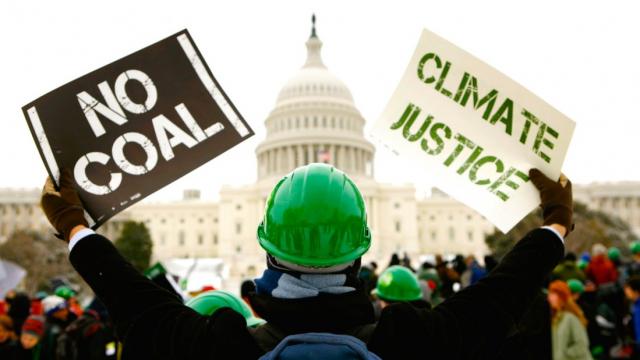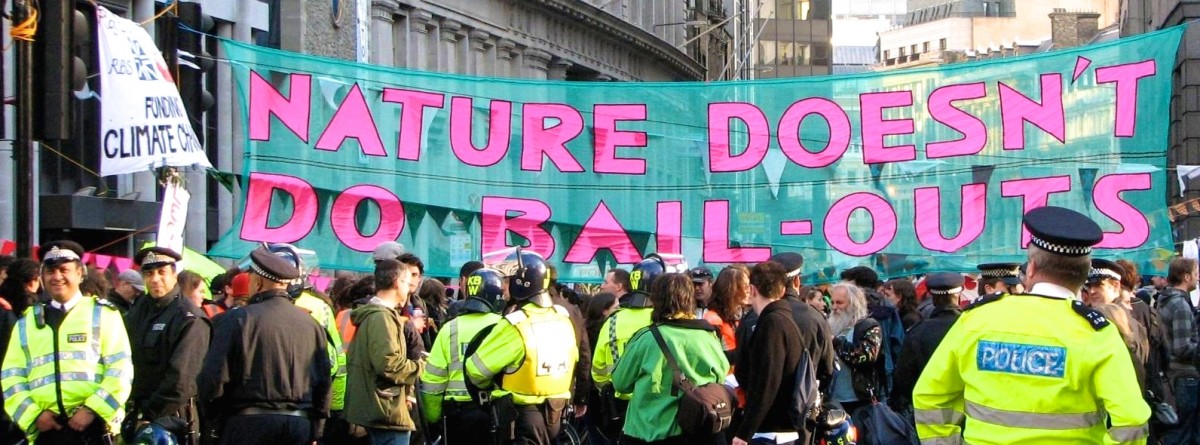
All of the elements required to create climate justice seem to be in place. The climate movement can put hundreds of thousands on the streets, organize creative civil resistance, get thousands to risk arrest and mobilize blockades of tar sands, fracking, oil pipelines and mountain top removal.
Polls show high levels of public support for taking action on climate change. A 2014 Gallup Poll shows 65% of Americans support emissions controls and a 2014 George Mason-Yale study found Americans were twice as likely to support a congressional or presidential candidate who strongly supports action to reduce global warming.
There is strong scientific consensus with the Intergovernmental Panel on Climate Change (IPCC) ringing the climate change alarm for two decades. In 2014, IPCC reports and the U.S. National Climate Assessment show that the climate crisis is here and affecting access to water, food production and health. The planet is in its Sixth Great Extinction, this one caused by humans. The World Health Organization estimates that climate change currently causes 150,000 deaths annually.
Yet, despite all of this, the climate change movement is unable to move U.S. or UN policy or force the economic system to respond adequately to the climate crisis.
The State of the Climate Movement
The climate movement has made tremendous strides in building the structure of a broader movement of movements over the past decade, and it will develop further via the events being organized around the next set of United Nations climate change meetings in New York this month.
At the global level, the movement of movements was formed outside the UN climate talks in Bali, the COP 13 in 2007. Calling themselves Climate Justice Now, more than thirty non-governmental organizations and social movements signed on to a statement that concluded with “We will take our struggle forward not just in the talks, but on the ground and in the streets.”
Climate Justice Now continued to meet after the COP 13 and grow. They developed a set of principles, organized alternative events at the COP meetings and published analyses of the UN’s climate negotiations. They participated inside the climate talks and engaged in direct action to protest the negotiations. Their organizing led to large demonstrations of more than 100,000 people and direct actions at the COP15 in Copenhagen in 2009 where 3,000 activists tried to "take over the conference for one day and transform it into a ‘People's Assembly’” to counter the “false solutions and elitism of the UN climate talks.” At the same time 300 people walked out of the conference and tried to hold an assembly with the protesters outside. The police disrupted them and more than 1,000 people were detained or arrested during COP15.
As we reported in a previous article, the U.S. spied on delegates and sabotaged the COP15. President Obama declared victory when he put forward a failed nonbinding agreement and Big Greens from the U.S. including the Natural Resources Defense Council, World Wildlife Federation and Sierra Club all declared victory despite the outcome.
In the U.S., a similar body formed during the 2010 U.S. Social Forum in Detroit. The Climate Justice Alliance is composed of frontline environmental and social justice organizations that work together to move local and state governments towards renewable energy and a just transition to the green energy economy. Across the country local groups have engaged in acts of resistance including blocking pipelines and protesting fracking, nuclear energy and mountain top removal among other forms of extreme energy extraction.
Big Greens vs Fresh Greens
One of the challenges in recent years was the conflict between these “big greens,” the traditional environmental groups, and fresh greensthat include frontline groups directly impacted by the excavation and transport of carbon and nuclear fuels. The anger between these groups can be seen in some of the writings of frontline activists who see the big greens as “quelling dissent.”
Tim DeChristopher, the climate justice advocate who went to prison for blocking the leasing of lands for gas in Utah, explained recently how the 2009 "cap and trade bill" was a turning point. Activists believed cap and trade was a false solution but the big greens said it was the only politically realistic possibility. When the bill failed, people realized the big greens not only pushed false solutions but also did not know what was politically realistic.
Part of the problem comes from money. Some major environmental groups, Sierra Club, NRDC and Environmental Defense Fund (EDF), took the position that methane gas was a "bridge fuel" from coal. Methane is a greenhouse gas obtained through fracking that has a much greater short term impact than carbon. After Corporate Crime Reporter started asking questions, it was revealed that the Sierra Club had taken $25 million from Chesapeake Energy, a firm heavily involved in fracking. Since then, under the direction of Michael Brune, the Sierra Club turned back an additional $30 million in gas donations.
Problems with big green environmental groups working with industries that profit from climate gasses continue. A recent report shows how EDF is supporting efforts for "safe fracking" (which, like "clean coal," doesn’t exist) through partnerships with gas corporations. Vera Scroggins, an anti-fracking activist, describes how these groups are “pouring money into calming fears and calming objections. They’re basically promoting something that’s been created by the industry.”
In recent years the divide between big greens and frontline activists has shrunk slightly. Research has shown that blockades and other aggressive actions work in stopping or slowing environmentally destructive actions. The increased use of civil resistance in the climate movement led the Sierra Club, for the first time, to engage in risking arrest with Michael Brune getting arrested at the White House.
There is still a long way to go to stop the division in the movement and get traditional environmental groups to treat climate change as an urgent disaster for which real solutions and not false compromises are needed. Beyond that, the movement needs to be broader than the environmental movement to include all who will be affected by the climate crisis. To achieve climate justice will require building a people-powered movement of movements that can have a significant impact on the tremendous wealth and power of the global financial elites who currently control the system.
3 WAYS TO SHOW YOUR SUPPORT
- Log in to post comments












